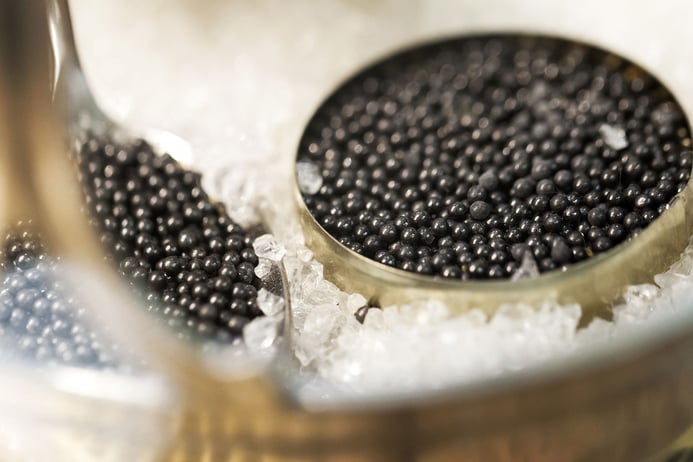Few dishes are as immediately associated with luxury and indulgence as caviar. The reputation of caviar alone can make these delicious and delicate orbs a bit intimidating for a novice, but don’t let that stand in your way.
What is Caviar?
Most people, even those without any interest in the hospitality industry, recognize that caviar refers to fish eggs. While this is partly correct, it is not entirely accurate. Caviar is not just any fish eggs. True caviar is composed of sturgeon eggs that are lightly salted or cured.
There are four different types of caviar: Almas, Beluga, Osciètre, and Sévruga. They vary in size, color, and flavor. These differences, as well as the availability of each individual type, play a role in determining the cost and value of each caviar.
Almas Caviar
In Russian, Almas means diamond. Almas is the most expensive and most exclusive type of caviar. Almas caviar has been enjoyed as a delicacy back as far as the ancient Greeks who imported it from the area now known as Crimea in the southern Ukraine. According to the Guinness Book of World Records, Almas caviar is regularly sold for $34,500 USD per kilogram, making it the most expensive food in the world.
What is about Almas caviar that makes it so costly? There are a few factors. Almas caviar comes exclusively from the albino beluga sturgeon that are more than 100 years old. While many sturgeons live to be over 100, albino beluga sturgeons are fairly rare, living mostly on the Iranian side of the Caspian Sea.
The eggs themselves are white and smooth. Caviar from sturgeons over 100 years old has a spongier texture than caviar from younger fish. The nuanced Almas caviar flavor profile is achieved through delicate salting which draws the caviar’s distinctive nutty, yet creamy taste.
Beluga Caviar
As with Almas, Beluga caviar is primarily from sturgeon that live in the Caspian Sea. As the second most costly type of caviar, Beluga caviar is perhaps what most people envision when they think of caviar. Although more common than Almas caviar, Beluga caviar is still relatively rare and was known to be reserved for prominent royal families in the past.
Beluga caviar has the largest individual eggs of all caviar. Each orb can be as large as a pea and ranges in color from a pale-silver or gray to a dark, inky black. The flavor is a balanced buttery saltiness. It is best enjoyed with minimal, simple accompaniments, such as on blini or toast points, rather than anything else that may distract from the delicate flavor of the caviar itself.
Osciètre Caviar
The Osciètre sturgeon is much smaller than the Beluga sturgeon. Originally from the Caspian Sea, much of the caviar-producing Osciètre sturgeon today are farmed to ensure the continued production of high-quality caviar.
Osciètre eggs are smaller than the large Beluga caviar but are still good sized grains that are consistent in size. The flavors of Osciètre caviar are subtle, with a definite marine taste. Osciètre caviar varies from deep brown to gold. The lighter colored eggs are from older sturgeons. They have a richer flavor and a higher price tag than those with a darker hue.
Sévruga Caviar
Sévruga sturgeon, also known in English as the starry sturgeon, is native to the Aegean, Azov, Black and Caspian Seas. However, the Sévruga caviar is only from the Caspian Seas Sévruga sturgeon.
The starry sturgeon is the most common caviar sturgeon and it also reproduces more quickly than the Beluga or Osciètre sturgeon. As a result, Sévruga caviar is the most available and least expensive caviar variety.
As the smallest caviar-producing sturgeon, the starry sturgeon also produces the smallest eggs. The eggs themselves are pearlescent light gray in color. The flavor profile includes a prominent marine flavor, followed by more delicate nutty and creamy notes.
While nothing can replace hands-on experience of tasting caviar, hopefully, this guide has given you a bit of background that you will find helpful.





